Risk Management for Woolworths Group Limited
VerifiedAdded on 2023/06/11
|18
|2817
|338
AI Summary
This report provides a risk management plan for Woolworths Group Limited, including a stakeholder analysis, SWOT and PEST analysis, and a context of risk analysis. The report also includes risk identification methods and a risk treatment plan.
Contribute Materials
Your contribution can guide someone’s learning journey. Share your
documents today.
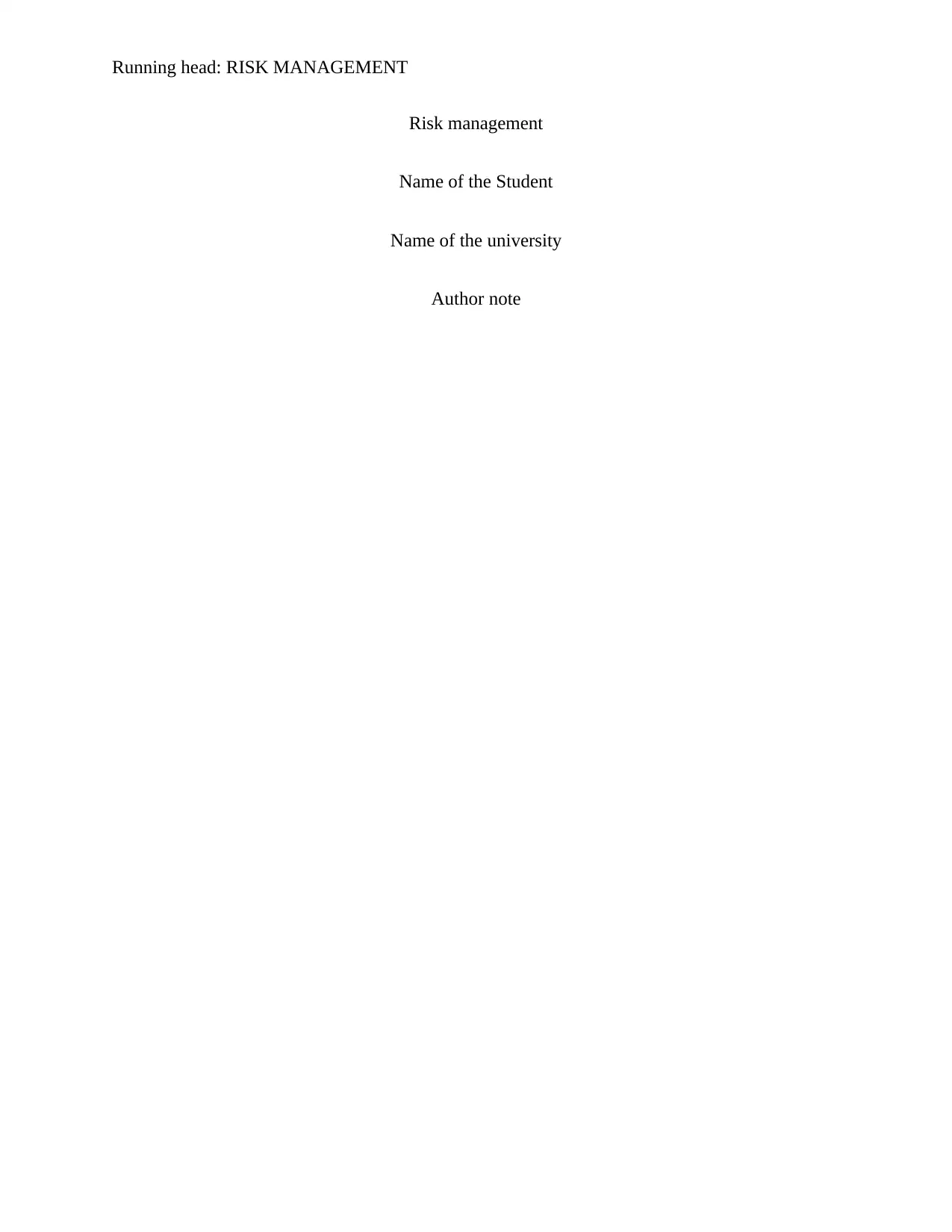
Running head: RISK MANAGEMENT
Risk management
Name of the Student
Name of the university
Author note
Risk management
Name of the Student
Name of the university
Author note
Secure Best Marks with AI Grader
Need help grading? Try our AI Grader for instant feedback on your assignments.
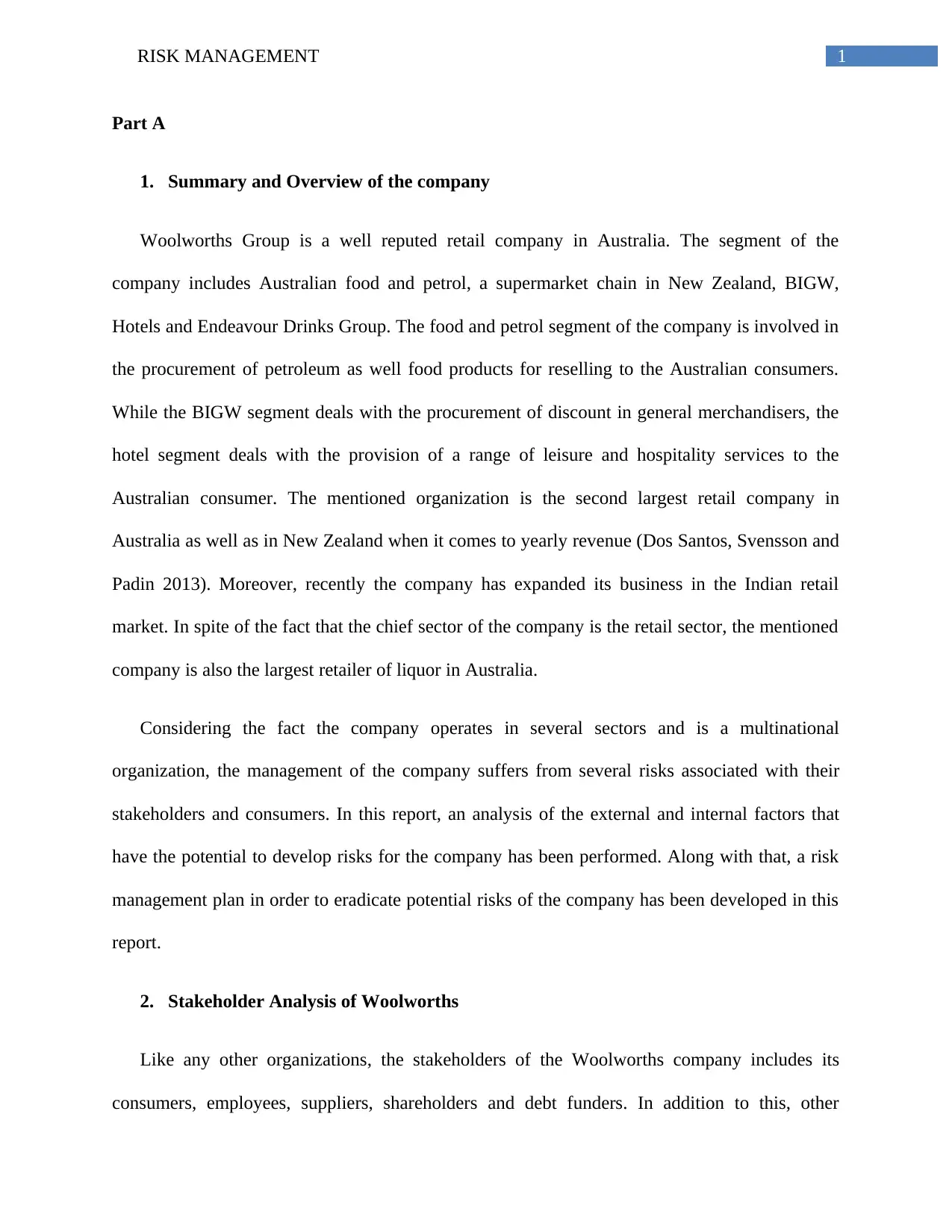
1RISK MANAGEMENT
Part A
1. Summary and Overview of the company
Woolworths Group is a well reputed retail company in Australia. The segment of the
company includes Australian food and petrol, a supermarket chain in New Zealand, BIGW,
Hotels and Endeavour Drinks Group. The food and petrol segment of the company is involved in
the procurement of petroleum as well food products for reselling to the Australian consumers.
While the BIGW segment deals with the procurement of discount in general merchandisers, the
hotel segment deals with the provision of a range of leisure and hospitality services to the
Australian consumer. The mentioned organization is the second largest retail company in
Australia as well as in New Zealand when it comes to yearly revenue (Dos Santos, Svensson and
Padin 2013). Moreover, recently the company has expanded its business in the Indian retail
market. In spite of the fact that the chief sector of the company is the retail sector, the mentioned
company is also the largest retailer of liquor in Australia.
Considering the fact the company operates in several sectors and is a multinational
organization, the management of the company suffers from several risks associated with their
stakeholders and consumers. In this report, an analysis of the external and internal factors that
have the potential to develop risks for the company has been performed. Along with that, a risk
management plan in order to eradicate potential risks of the company has been developed in this
report.
2. Stakeholder Analysis of Woolworths
Like any other organizations, the stakeholders of the Woolworths company includes its
consumers, employees, suppliers, shareholders and debt funders. In addition to this, other
Part A
1. Summary and Overview of the company
Woolworths Group is a well reputed retail company in Australia. The segment of the
company includes Australian food and petrol, a supermarket chain in New Zealand, BIGW,
Hotels and Endeavour Drinks Group. The food and petrol segment of the company is involved in
the procurement of petroleum as well food products for reselling to the Australian consumers.
While the BIGW segment deals with the procurement of discount in general merchandisers, the
hotel segment deals with the provision of a range of leisure and hospitality services to the
Australian consumer. The mentioned organization is the second largest retail company in
Australia as well as in New Zealand when it comes to yearly revenue (Dos Santos, Svensson and
Padin 2013). Moreover, recently the company has expanded its business in the Indian retail
market. In spite of the fact that the chief sector of the company is the retail sector, the mentioned
company is also the largest retailer of liquor in Australia.
Considering the fact the company operates in several sectors and is a multinational
organization, the management of the company suffers from several risks associated with their
stakeholders and consumers. In this report, an analysis of the external and internal factors that
have the potential to develop risks for the company has been performed. Along with that, a risk
management plan in order to eradicate potential risks of the company has been developed in this
report.
2. Stakeholder Analysis of Woolworths
Like any other organizations, the stakeholders of the Woolworths company includes its
consumers, employees, suppliers, shareholders and debt funders. In addition to this, other
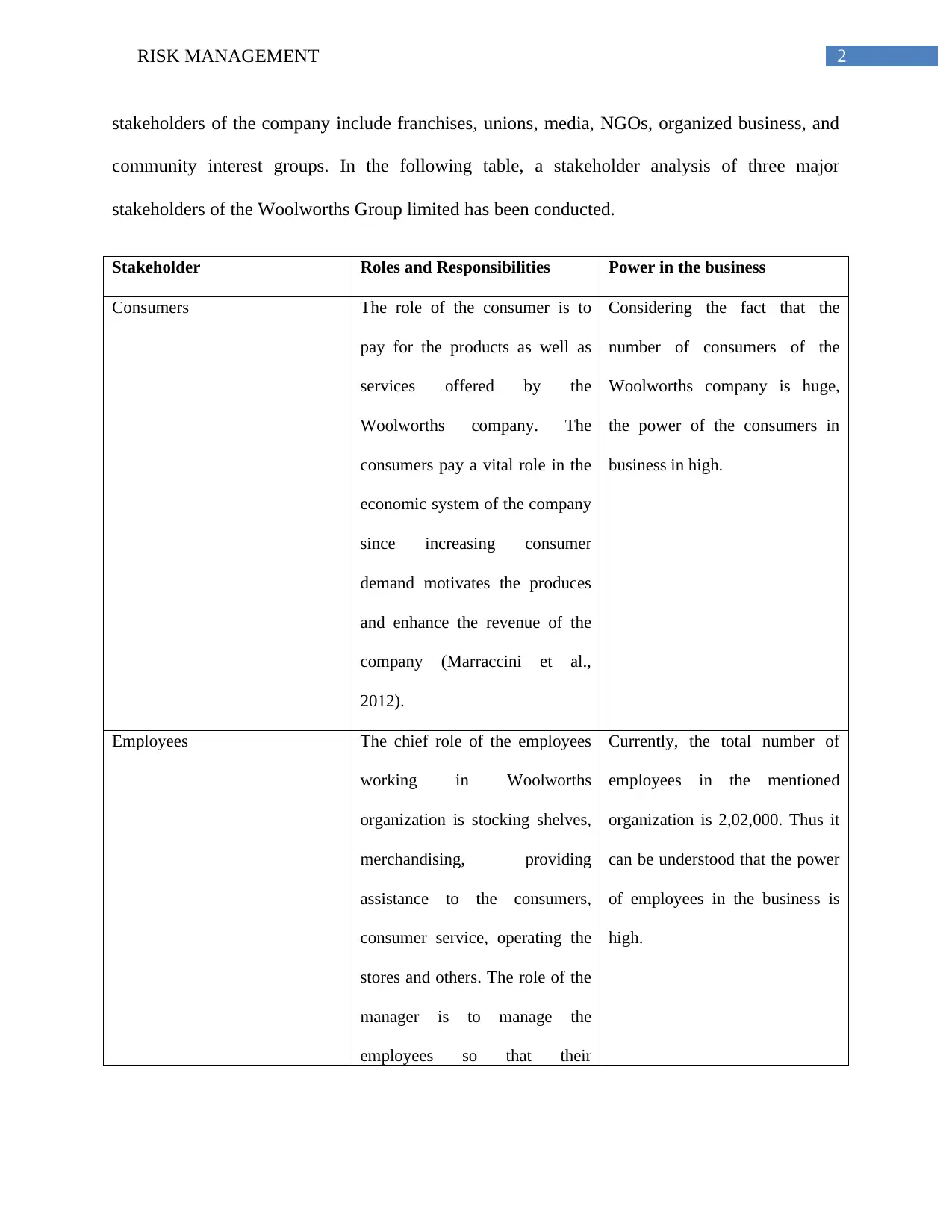
2RISK MANAGEMENT
stakeholders of the company include franchises, unions, media, NGOs, organized business, and
community interest groups. In the following table, a stakeholder analysis of three major
stakeholders of the Woolworths Group limited has been conducted.
Stakeholder Roles and Responsibilities Power in the business
Consumers The role of the consumer is to
pay for the products as well as
services offered by the
Woolworths company. The
consumers pay a vital role in the
economic system of the company
since increasing consumer
demand motivates the produces
and enhance the revenue of the
company (Marraccini et al.,
2012).
Considering the fact that the
number of consumers of the
Woolworths company is huge,
the power of the consumers in
business in high.
Employees The chief role of the employees
working in Woolworths
organization is stocking shelves,
merchandising, providing
assistance to the consumers,
consumer service, operating the
stores and others. The role of the
manager is to manage the
employees so that their
Currently, the total number of
employees in the mentioned
organization is 2,02,000. Thus it
can be understood that the power
of employees in the business is
high.
stakeholders of the company include franchises, unions, media, NGOs, organized business, and
community interest groups. In the following table, a stakeholder analysis of three major
stakeholders of the Woolworths Group limited has been conducted.
Stakeholder Roles and Responsibilities Power in the business
Consumers The role of the consumer is to
pay for the products as well as
services offered by the
Woolworths company. The
consumers pay a vital role in the
economic system of the company
since increasing consumer
demand motivates the produces
and enhance the revenue of the
company (Marraccini et al.,
2012).
Considering the fact that the
number of consumers of the
Woolworths company is huge,
the power of the consumers in
business in high.
Employees The chief role of the employees
working in Woolworths
organization is stocking shelves,
merchandising, providing
assistance to the consumers,
consumer service, operating the
stores and others. The role of the
manager is to manage the
employees so that their
Currently, the total number of
employees in the mentioned
organization is 2,02,000. Thus it
can be understood that the power
of employees in the business is
high.
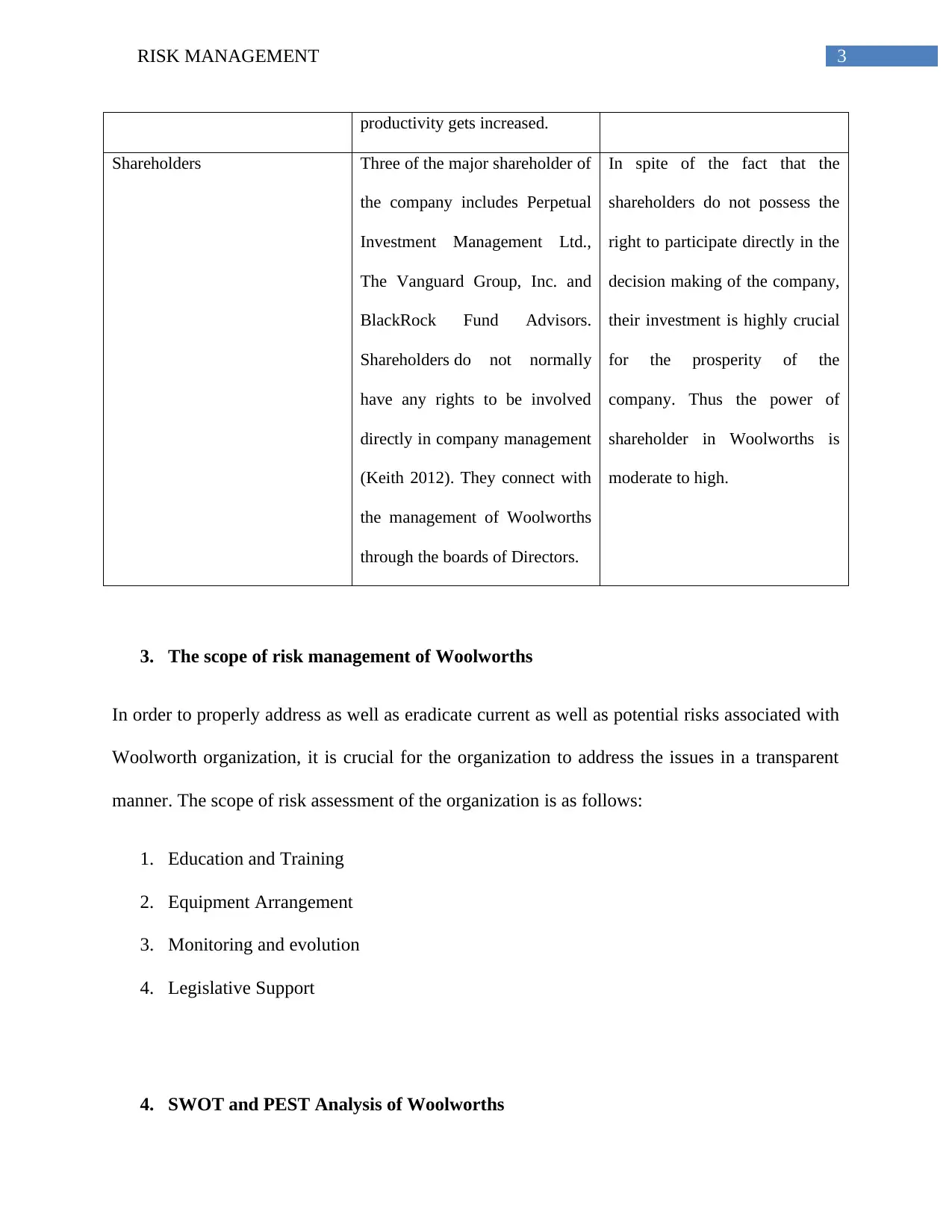
3RISK MANAGEMENT
productivity gets increased.
Shareholders Three of the major shareholder of
the company includes Perpetual
Investment Management Ltd.,
The Vanguard Group, Inc. and
BlackRock Fund Advisors.
Shareholders do not normally
have any rights to be involved
directly in company management
(Keith 2012). They connect with
the management of Woolworths
through the boards of Directors.
In spite of the fact that the
shareholders do not possess the
right to participate directly in the
decision making of the company,
their investment is highly crucial
for the prosperity of the
company. Thus the power of
shareholder in Woolworths is
moderate to high.
3. The scope of risk management of Woolworths
In order to properly address as well as eradicate current as well as potential risks associated with
Woolworth organization, it is crucial for the organization to address the issues in a transparent
manner. The scope of risk assessment of the organization is as follows:
1. Education and Training
2. Equipment Arrangement
3. Monitoring and evolution
4. Legislative Support
4. SWOT and PEST Analysis of Woolworths
productivity gets increased.
Shareholders Three of the major shareholder of
the company includes Perpetual
Investment Management Ltd.,
The Vanguard Group, Inc. and
BlackRock Fund Advisors.
Shareholders do not normally
have any rights to be involved
directly in company management
(Keith 2012). They connect with
the management of Woolworths
through the boards of Directors.
In spite of the fact that the
shareholders do not possess the
right to participate directly in the
decision making of the company,
their investment is highly crucial
for the prosperity of the
company. Thus the power of
shareholder in Woolworths is
moderate to high.
3. The scope of risk management of Woolworths
In order to properly address as well as eradicate current as well as potential risks associated with
Woolworth organization, it is crucial for the organization to address the issues in a transparent
manner. The scope of risk assessment of the organization is as follows:
1. Education and Training
2. Equipment Arrangement
3. Monitoring and evolution
4. Legislative Support
4. SWOT and PEST Analysis of Woolworths
Secure Best Marks with AI Grader
Need help grading? Try our AI Grader for instant feedback on your assignments.
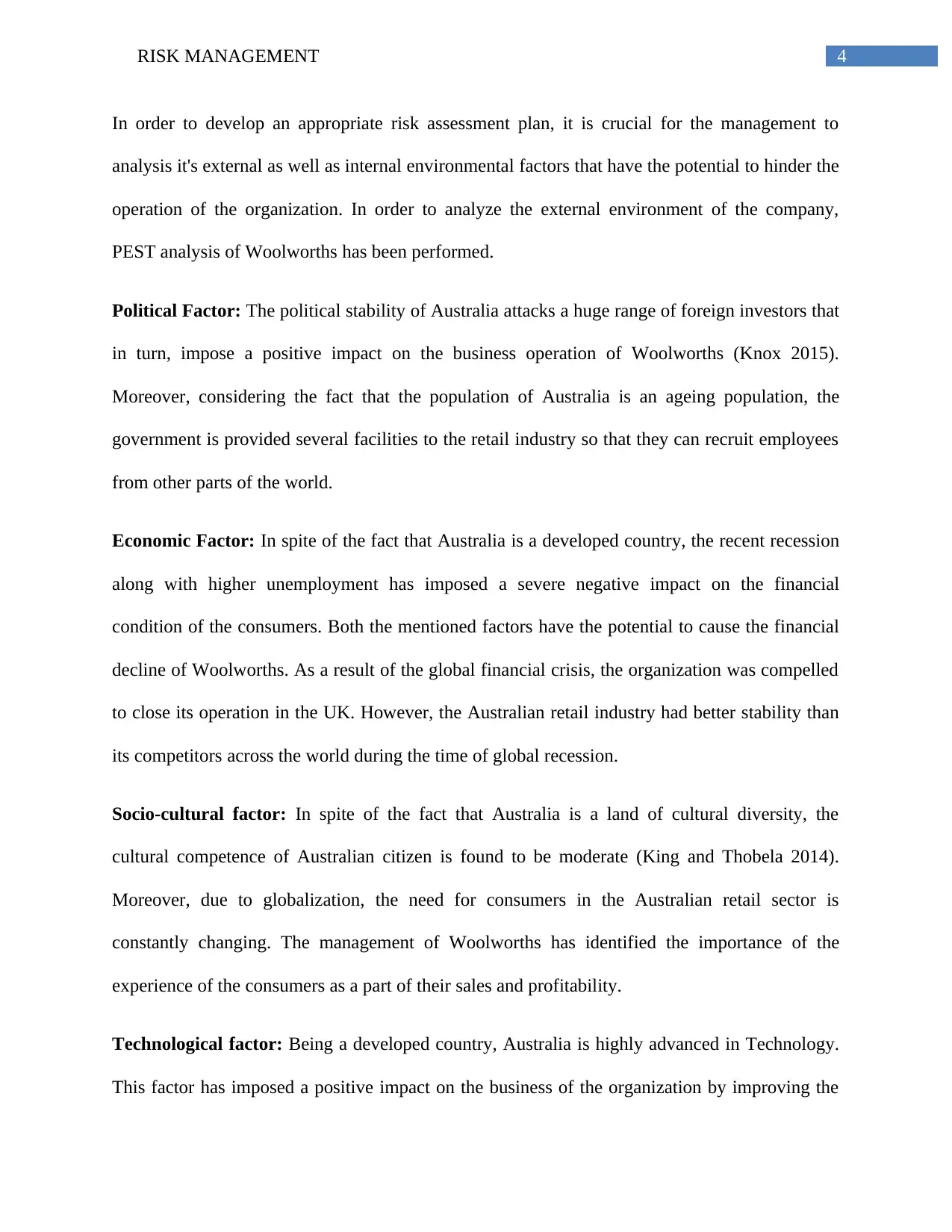
4RISK MANAGEMENT
In order to develop an appropriate risk assessment plan, it is crucial for the management to
analysis it's external as well as internal environmental factors that have the potential to hinder the
operation of the organization. In order to analyze the external environment of the company,
PEST analysis of Woolworths has been performed.
Political Factor: The political stability of Australia attacks a huge range of foreign investors that
in turn, impose a positive impact on the business operation of Woolworths (Knox 2015).
Moreover, considering the fact that the population of Australia is an ageing population, the
government is provided several facilities to the retail industry so that they can recruit employees
from other parts of the world.
Economic Factor: In spite of the fact that Australia is a developed country, the recent recession
along with higher unemployment has imposed a severe negative impact on the financial
condition of the consumers. Both the mentioned factors have the potential to cause the financial
decline of Woolworths. As a result of the global financial crisis, the organization was compelled
to close its operation in the UK. However, the Australian retail industry had better stability than
its competitors across the world during the time of global recession.
Socio-cultural factor: In spite of the fact that Australia is a land of cultural diversity, the
cultural competence of Australian citizen is found to be moderate (King and Thobela 2014).
Moreover, due to globalization, the need for consumers in the Australian retail sector is
constantly changing. The management of Woolworths has identified the importance of the
experience of the consumers as a part of their sales and profitability.
Technological factor: Being a developed country, Australia is highly advanced in Technology.
This factor has imposed a positive impact on the business of the organization by improving the
In order to develop an appropriate risk assessment plan, it is crucial for the management to
analysis it's external as well as internal environmental factors that have the potential to hinder the
operation of the organization. In order to analyze the external environment of the company,
PEST analysis of Woolworths has been performed.
Political Factor: The political stability of Australia attacks a huge range of foreign investors that
in turn, impose a positive impact on the business operation of Woolworths (Knox 2015).
Moreover, considering the fact that the population of Australia is an ageing population, the
government is provided several facilities to the retail industry so that they can recruit employees
from other parts of the world.
Economic Factor: In spite of the fact that Australia is a developed country, the recent recession
along with higher unemployment has imposed a severe negative impact on the financial
condition of the consumers. Both the mentioned factors have the potential to cause the financial
decline of Woolworths. As a result of the global financial crisis, the organization was compelled
to close its operation in the UK. However, the Australian retail industry had better stability than
its competitors across the world during the time of global recession.
Socio-cultural factor: In spite of the fact that Australia is a land of cultural diversity, the
cultural competence of Australian citizen is found to be moderate (King and Thobela 2014).
Moreover, due to globalization, the need for consumers in the Australian retail sector is
constantly changing. The management of Woolworths has identified the importance of the
experience of the consumers as a part of their sales and profitability.
Technological factor: Being a developed country, Australia is highly advanced in Technology.
This factor has imposed a positive impact on the business of the organization by improving the
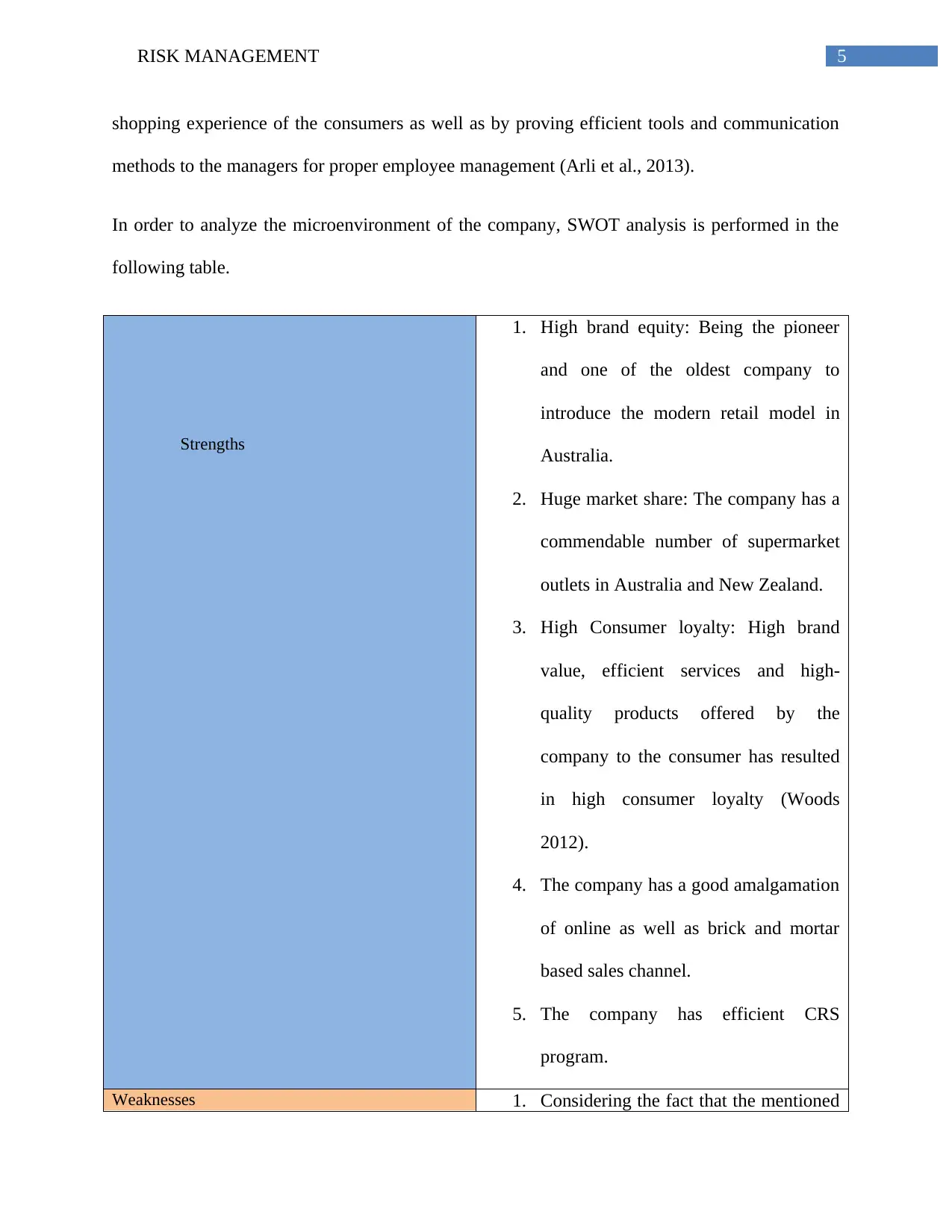
5RISK MANAGEMENT
shopping experience of the consumers as well as by proving efficient tools and communication
methods to the managers for proper employee management (Arli et al., 2013).
In order to analyze the microenvironment of the company, SWOT analysis is performed in the
following table.
Strengths
1. High brand equity: Being the pioneer
and one of the oldest company to
introduce the modern retail model in
Australia.
2. Huge market share: The company has a
commendable number of supermarket
outlets in Australia and New Zealand.
3. High Consumer loyalty: High brand
value, efficient services and high-
quality products offered by the
company to the consumer has resulted
in high consumer loyalty (Woods
2012).
4. The company has a good amalgamation
of online as well as brick and mortar
based sales channel.
5. The company has efficient CRS
program.
Weaknesses 1. Considering the fact that the mentioned
shopping experience of the consumers as well as by proving efficient tools and communication
methods to the managers for proper employee management (Arli et al., 2013).
In order to analyze the microenvironment of the company, SWOT analysis is performed in the
following table.
Strengths
1. High brand equity: Being the pioneer
and one of the oldest company to
introduce the modern retail model in
Australia.
2. Huge market share: The company has a
commendable number of supermarket
outlets in Australia and New Zealand.
3. High Consumer loyalty: High brand
value, efficient services and high-
quality products offered by the
company to the consumer has resulted
in high consumer loyalty (Woods
2012).
4. The company has a good amalgamation
of online as well as brick and mortar
based sales channel.
5. The company has efficient CRS
program.
Weaknesses 1. Considering the fact that the mentioned
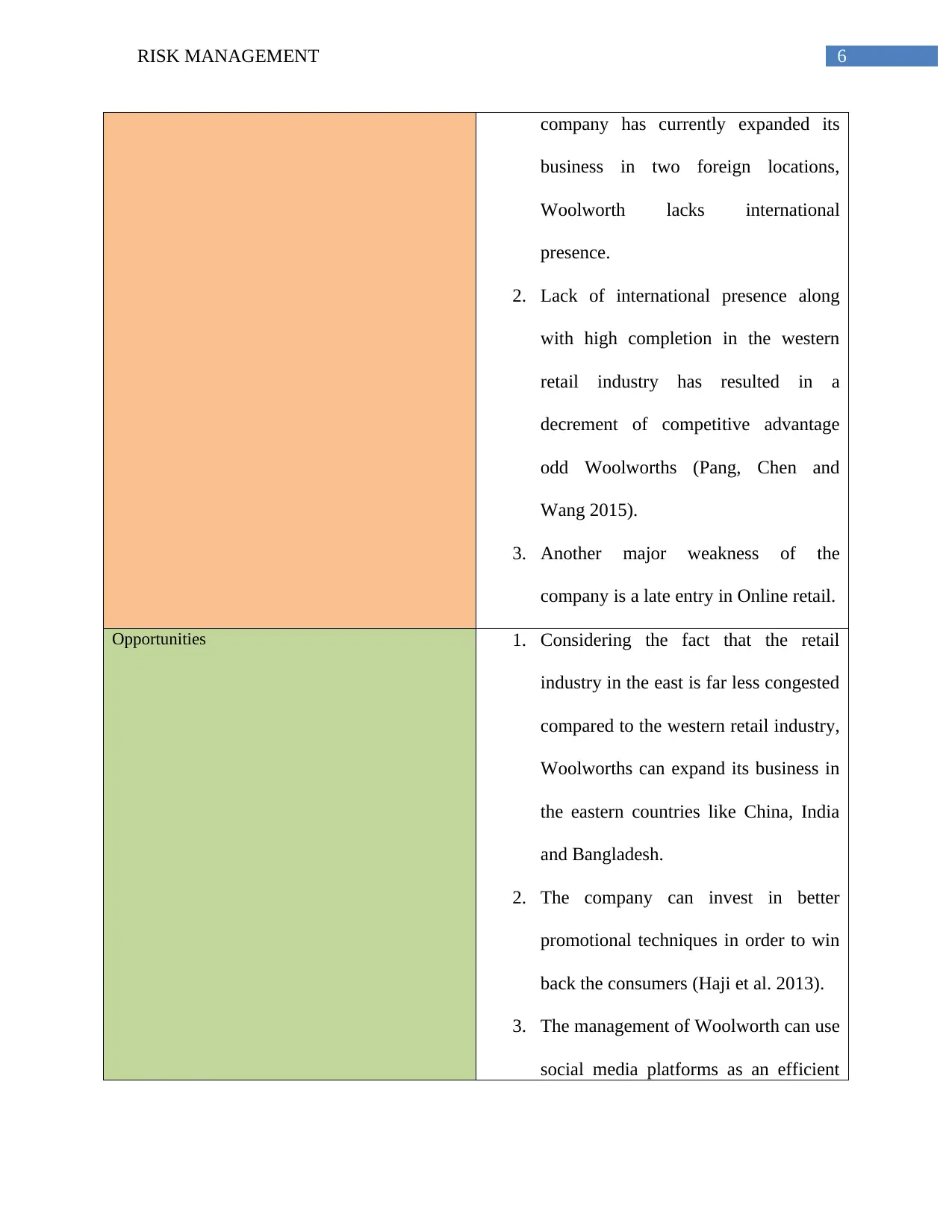
6RISK MANAGEMENT
company has currently expanded its
business in two foreign locations,
Woolworth lacks international
presence.
2. Lack of international presence along
with high completion in the western
retail industry has resulted in a
decrement of competitive advantage
odd Woolworths (Pang, Chen and
Wang 2015).
3. Another major weakness of the
company is a late entry in Online retail.
Opportunities 1. Considering the fact that the retail
industry in the east is far less congested
compared to the western retail industry,
Woolworths can expand its business in
the eastern countries like China, India
and Bangladesh.
2. The company can invest in better
promotional techniques in order to win
back the consumers (Haji et al. 2013).
3. The management of Woolworth can use
social media platforms as an efficient
company has currently expanded its
business in two foreign locations,
Woolworth lacks international
presence.
2. Lack of international presence along
with high completion in the western
retail industry has resulted in a
decrement of competitive advantage
odd Woolworths (Pang, Chen and
Wang 2015).
3. Another major weakness of the
company is a late entry in Online retail.
Opportunities 1. Considering the fact that the retail
industry in the east is far less congested
compared to the western retail industry,
Woolworths can expand its business in
the eastern countries like China, India
and Bangladesh.
2. The company can invest in better
promotional techniques in order to win
back the consumers (Haji et al. 2013).
3. The management of Woolworth can use
social media platforms as an efficient
Paraphrase This Document
Need a fresh take? Get an instant paraphrase of this document with our AI Paraphraser
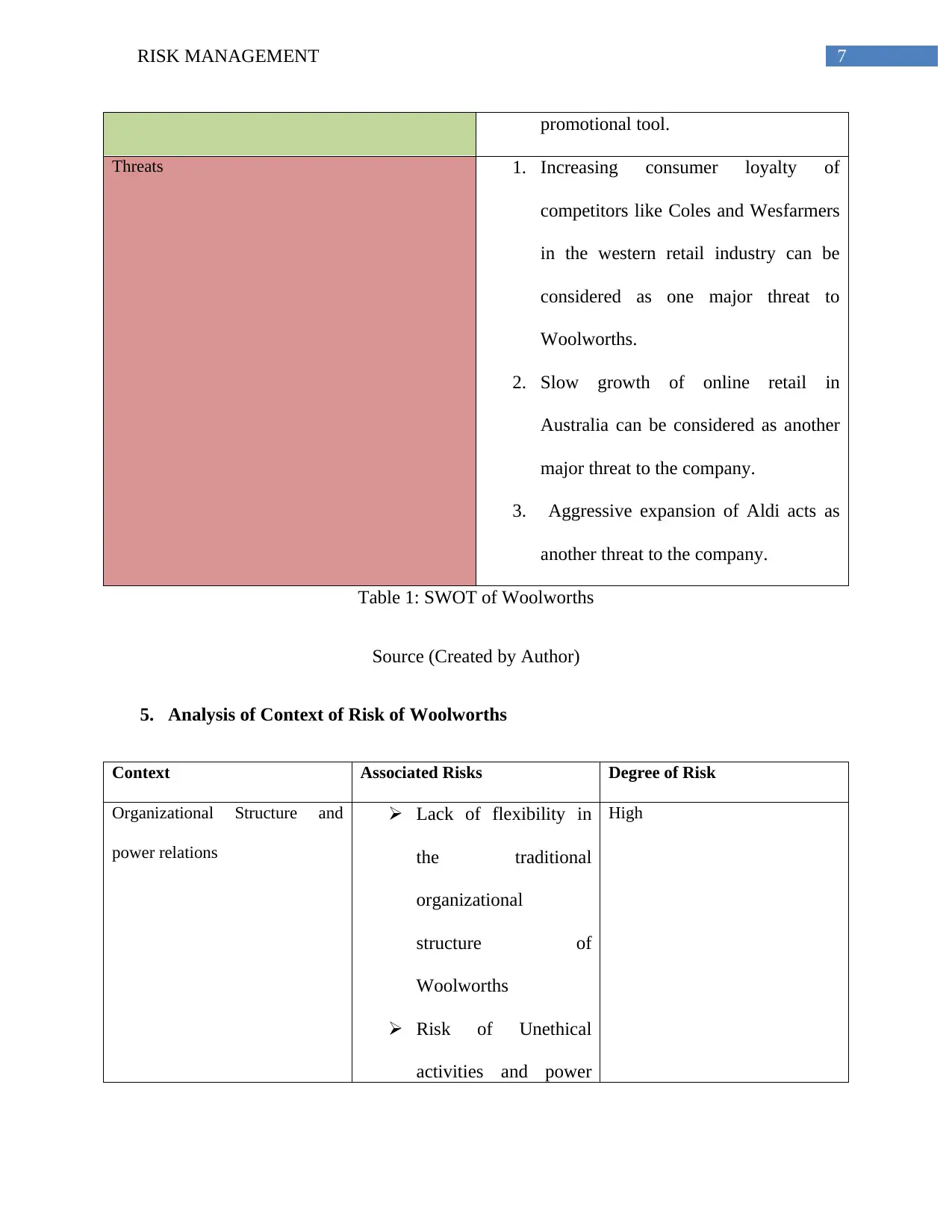
7RISK MANAGEMENT
promotional tool.
Threats 1. Increasing consumer loyalty of
competitors like Coles and Wesfarmers
in the western retail industry can be
considered as one major threat to
Woolworths.
2. Slow growth of online retail in
Australia can be considered as another
major threat to the company.
3. Aggressive expansion of Aldi acts as
another threat to the company.
Table 1: SWOT of Woolworths
Source (Created by Author)
5. Analysis of Context of Risk of Woolworths
Context Associated Risks Degree of Risk
Organizational Structure and
power relations
Lack of flexibility in
the traditional
organizational
structure of
Woolworths
Risk of Unethical
activities and power
High
promotional tool.
Threats 1. Increasing consumer loyalty of
competitors like Coles and Wesfarmers
in the western retail industry can be
considered as one major threat to
Woolworths.
2. Slow growth of online retail in
Australia can be considered as another
major threat to the company.
3. Aggressive expansion of Aldi acts as
another threat to the company.
Table 1: SWOT of Woolworths
Source (Created by Author)
5. Analysis of Context of Risk of Woolworths
Context Associated Risks Degree of Risk
Organizational Structure and
power relations
Lack of flexibility in
the traditional
organizational
structure of
Woolworths
Risk of Unethical
activities and power
High
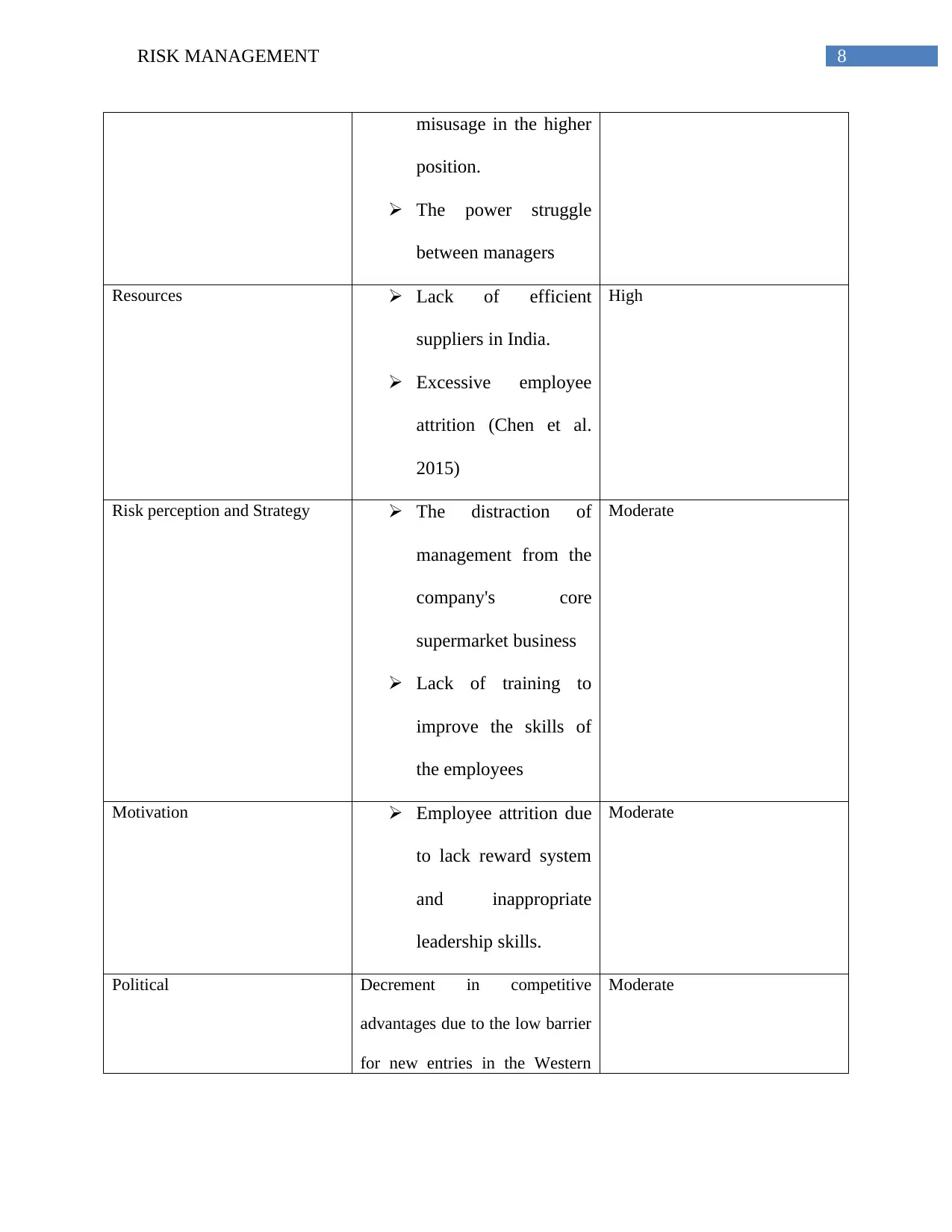
8RISK MANAGEMENT
misusage in the higher
position.
The power struggle
between managers
Resources Lack of efficient
suppliers in India.
Excessive employee
attrition (Chen et al.
2015)
High
Risk perception and Strategy The distraction of
management from the
company's core
supermarket business
Lack of training to
improve the skills of
the employees
Moderate
Motivation Employee attrition due
to lack reward system
and inappropriate
leadership skills.
Moderate
Political Decrement in competitive
advantages due to the low barrier
for new entries in the Western
Moderate
misusage in the higher
position.
The power struggle
between managers
Resources Lack of efficient
suppliers in India.
Excessive employee
attrition (Chen et al.
2015)
High
Risk perception and Strategy The distraction of
management from the
company's core
supermarket business
Lack of training to
improve the skills of
the employees
Moderate
Motivation Employee attrition due
to lack reward system
and inappropriate
leadership skills.
Moderate
Political Decrement in competitive
advantages due to the low barrier
for new entries in the Western
Moderate
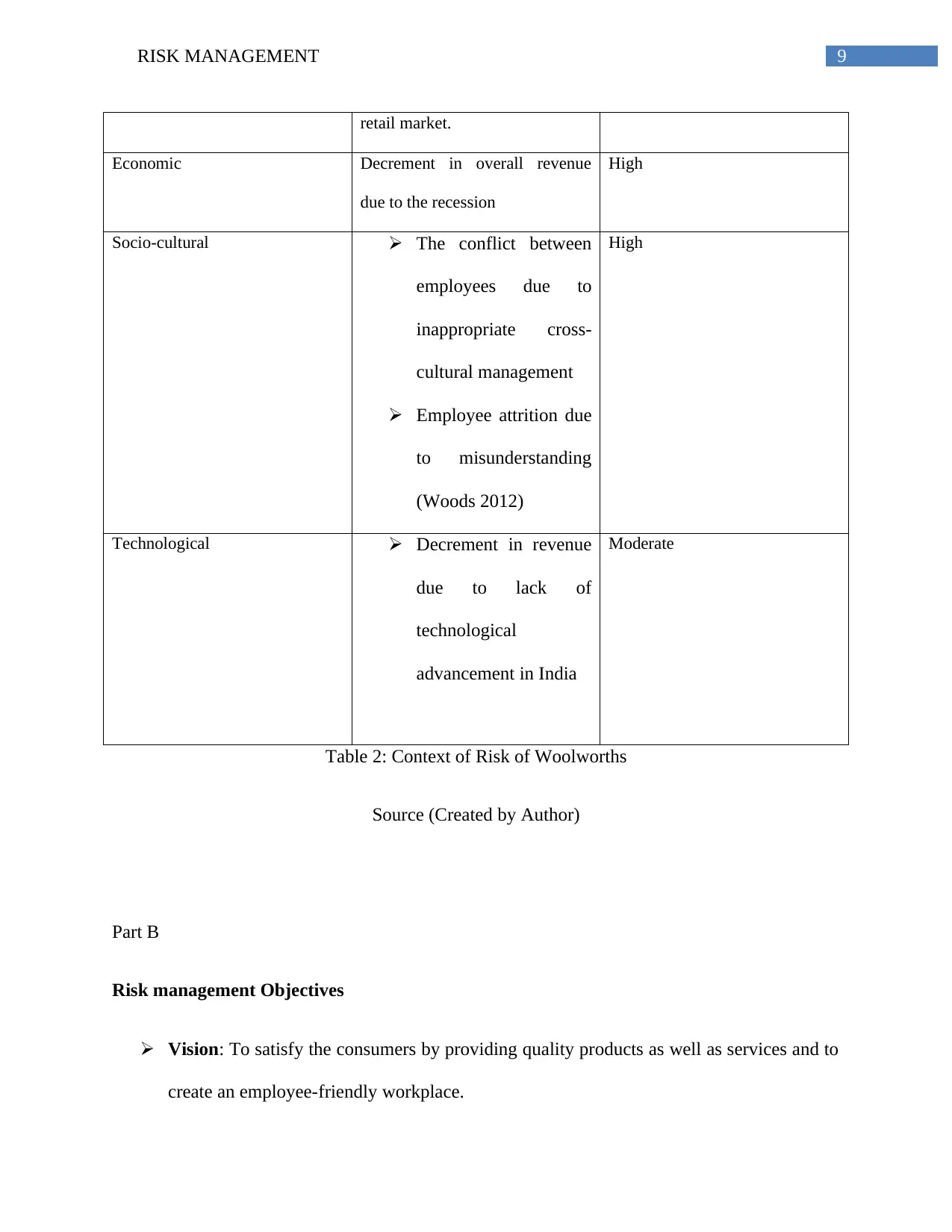
9RISK MANAGEMENT
retail market.
Economic Decrement in overall revenue
due to the recession
High
Socio-cultural The conflict between
employees due to
inappropriate cross-
cultural management
Employee attrition due
to misunderstanding
(Woods 2012)
High
Technological Decrement in revenue
due to lack of
technological
advancement in India
Moderate
Table 2: Context of Risk of Woolworths
Source (Created by Author)
Part B
Risk management Objectives
Vision: To satisfy the consumers by providing quality products as well as services and to
create an employee-friendly workplace.
retail market.
Economic Decrement in overall revenue
due to the recession
High
Socio-cultural The conflict between
employees due to
inappropriate cross-
cultural management
Employee attrition due
to misunderstanding
(Woods 2012)
High
Technological Decrement in revenue
due to lack of
technological
advancement in India
Moderate
Table 2: Context of Risk of Woolworths
Source (Created by Author)
Part B
Risk management Objectives
Vision: To satisfy the consumers by providing quality products as well as services and to
create an employee-friendly workplace.
Secure Best Marks with AI Grader
Need help grading? Try our AI Grader for instant feedback on your assignments.
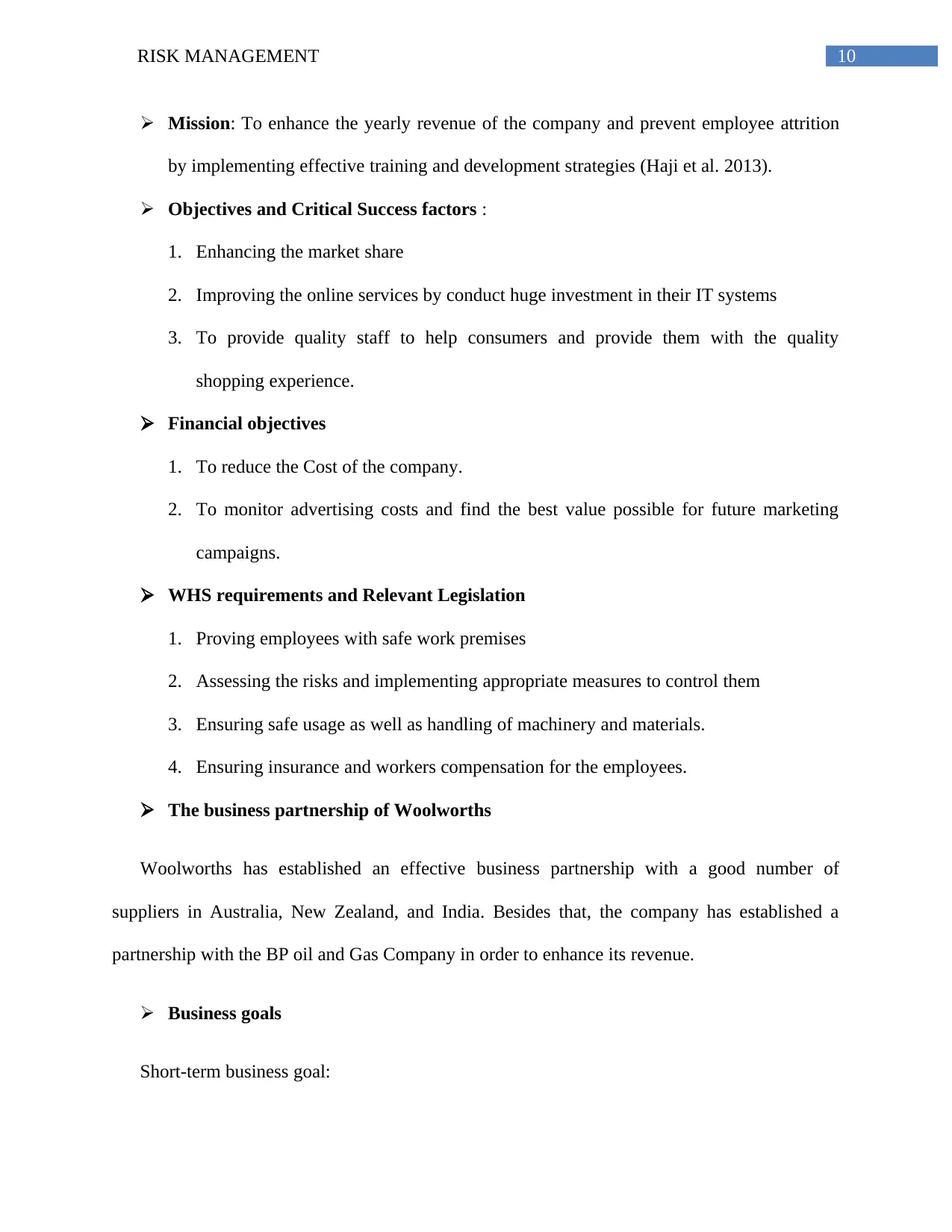
10RISK MANAGEMENT
Mission: To enhance the yearly revenue of the company and prevent employee attrition
by implementing effective training and development strategies (Haji et al. 2013).
Objectives and Critical Success factors :
1. Enhancing the market share
2. Improving the online services by conduct huge investment in their IT systems
3. To provide quality staff to help consumers and provide them with the quality
shopping experience.
Financial objectives
1. To reduce the Cost of the company.
2. To monitor advertising costs and find the best value possible for future marketing
campaigns.
WHS requirements and Relevant Legislation
1. Proving employees with safe work premises
2. Assessing the risks and implementing appropriate measures to control them
3. Ensuring safe usage as well as handling of machinery and materials.
4. Ensuring insurance and workers compensation for the employees.
The business partnership of Woolworths
Woolworths has established an effective business partnership with a good number of
suppliers in Australia, New Zealand, and India. Besides that, the company has established a
partnership with the BP oil and Gas Company in order to enhance its revenue.
Business goals
Short-term business goal:
Mission: To enhance the yearly revenue of the company and prevent employee attrition
by implementing effective training and development strategies (Haji et al. 2013).
Objectives and Critical Success factors :
1. Enhancing the market share
2. Improving the online services by conduct huge investment in their IT systems
3. To provide quality staff to help consumers and provide them with the quality
shopping experience.
Financial objectives
1. To reduce the Cost of the company.
2. To monitor advertising costs and find the best value possible for future marketing
campaigns.
WHS requirements and Relevant Legislation
1. Proving employees with safe work premises
2. Assessing the risks and implementing appropriate measures to control them
3. Ensuring safe usage as well as handling of machinery and materials.
4. Ensuring insurance and workers compensation for the employees.
The business partnership of Woolworths
Woolworths has established an effective business partnership with a good number of
suppliers in Australia, New Zealand, and India. Besides that, the company has established a
partnership with the BP oil and Gas Company in order to enhance its revenue.
Business goals
Short-term business goal:
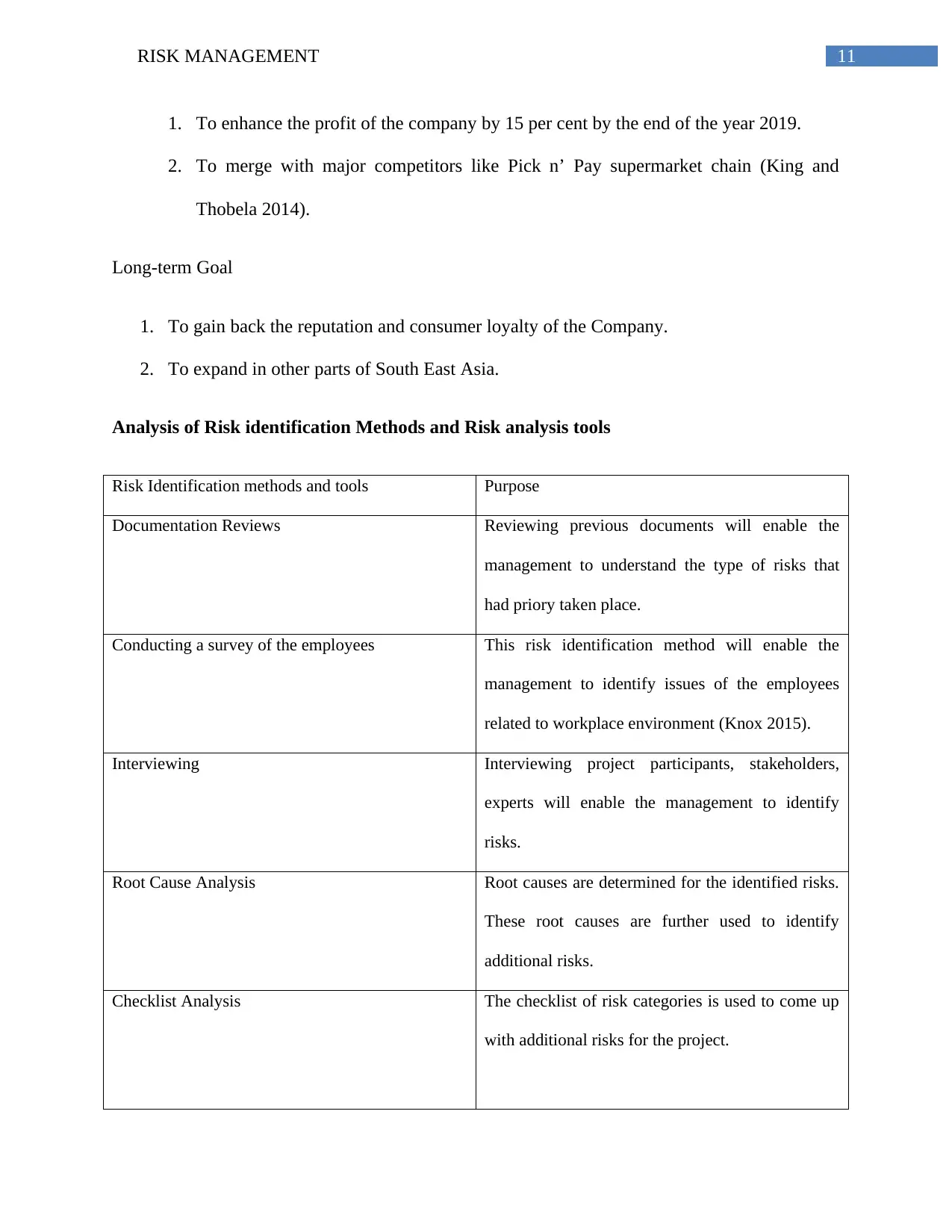
11RISK MANAGEMENT
1. To enhance the profit of the company by 15 per cent by the end of the year 2019.
2. To merge with major competitors like Pick n’ Pay supermarket chain (King and
Thobela 2014).
Long-term Goal
1. To gain back the reputation and consumer loyalty of the Company.
2. To expand in other parts of South East Asia.
Analysis of Risk identification Methods and Risk analysis tools
Risk Identification methods and tools Purpose
Documentation Reviews Reviewing previous documents will enable the
management to understand the type of risks that
had priory taken place.
Conducting a survey of the employees This risk identification method will enable the
management to identify issues of the employees
related to workplace environment (Knox 2015).
Interviewing Interviewing project participants, stakeholders,
experts will enable the management to identify
risks.
Root Cause Analysis Root causes are determined for the identified risks.
These root causes are further used to identify
additional risks.
Checklist Analysis The checklist of risk categories is used to come up
with additional risks for the project.
1. To enhance the profit of the company by 15 per cent by the end of the year 2019.
2. To merge with major competitors like Pick n’ Pay supermarket chain (King and
Thobela 2014).
Long-term Goal
1. To gain back the reputation and consumer loyalty of the Company.
2. To expand in other parts of South East Asia.
Analysis of Risk identification Methods and Risk analysis tools
Risk Identification methods and tools Purpose
Documentation Reviews Reviewing previous documents will enable the
management to understand the type of risks that
had priory taken place.
Conducting a survey of the employees This risk identification method will enable the
management to identify issues of the employees
related to workplace environment (Knox 2015).
Interviewing Interviewing project participants, stakeholders,
experts will enable the management to identify
risks.
Root Cause Analysis Root causes are determined for the identified risks.
These root causes are further used to identify
additional risks.
Checklist Analysis The checklist of risk categories is used to come up
with additional risks for the project.
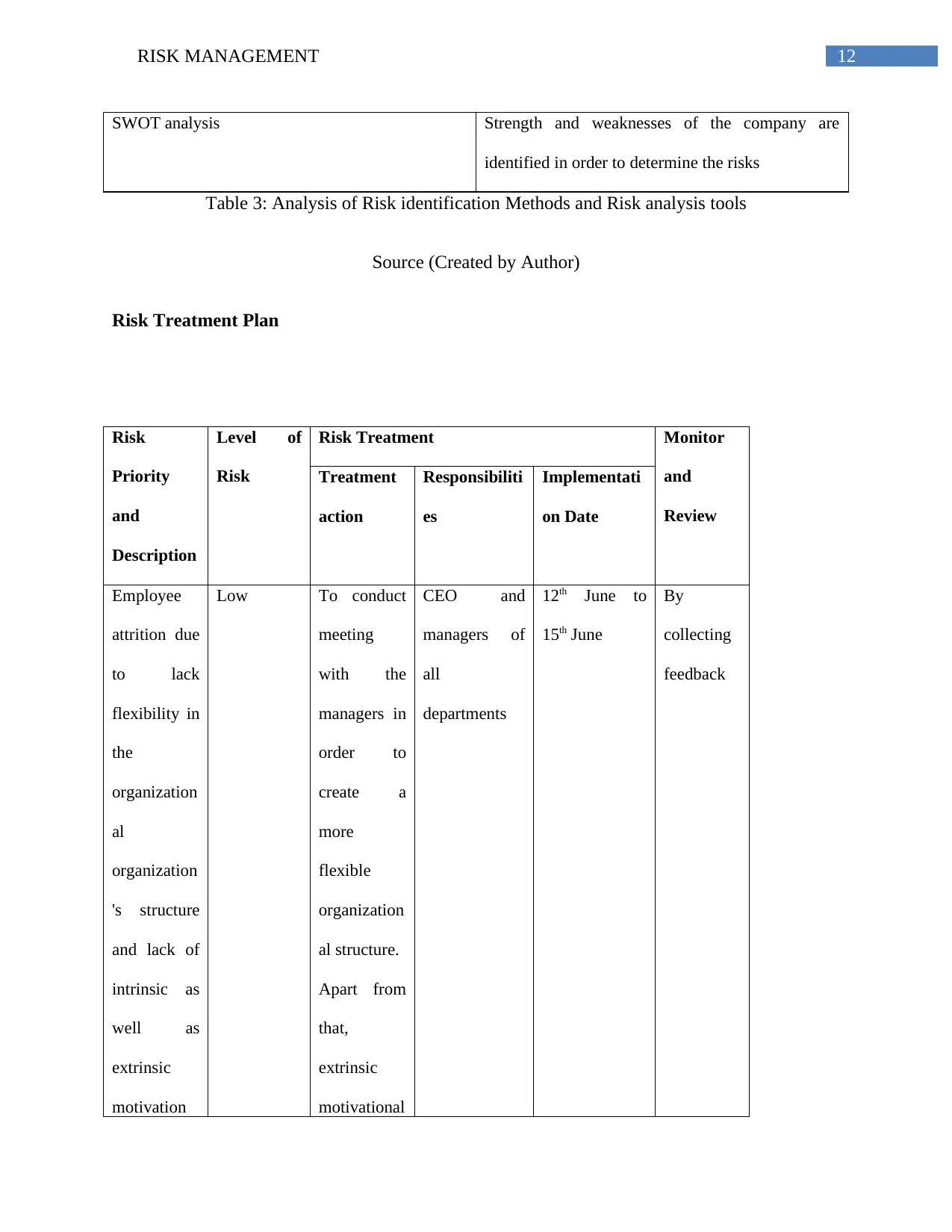
12RISK MANAGEMENT
SWOT analysis Strength and weaknesses of the company are
identified in order to determine the risks
Table 3: Analysis of Risk identification Methods and Risk analysis tools
Source (Created by Author)
Risk Treatment Plan
Risk
Priority
and
Description
Level of
Risk
Risk Treatment Monitor
and
Review
Treatment
action
Responsibiliti
es
Implementati
on Date
Employee
attrition due
to lack
flexibility in
the
organization
al
organization
's structure
and lack of
intrinsic as
well as
extrinsic
motivation
Low To conduct
meeting
with the
managers in
order to
create a
more
flexible
organization
al structure.
Apart from
that,
extrinsic
motivational
CEO and
managers of
all
departments
12th June to
15th June
By
collecting
feedback
SWOT analysis Strength and weaknesses of the company are
identified in order to determine the risks
Table 3: Analysis of Risk identification Methods and Risk analysis tools
Source (Created by Author)
Risk Treatment Plan
Risk
Priority
and
Description
Level of
Risk
Risk Treatment Monitor
and
Review
Treatment
action
Responsibiliti
es
Implementati
on Date
Employee
attrition due
to lack
flexibility in
the
organization
al
organization
's structure
and lack of
intrinsic as
well as
extrinsic
motivation
Low To conduct
meeting
with the
managers in
order to
create a
more
flexible
organization
al structure.
Apart from
that,
extrinsic
motivational
CEO and
managers of
all
departments
12th June to
15th June
By
collecting
feedback
Paraphrase This Document
Need a fresh take? Get an instant paraphrase of this document with our AI Paraphraser
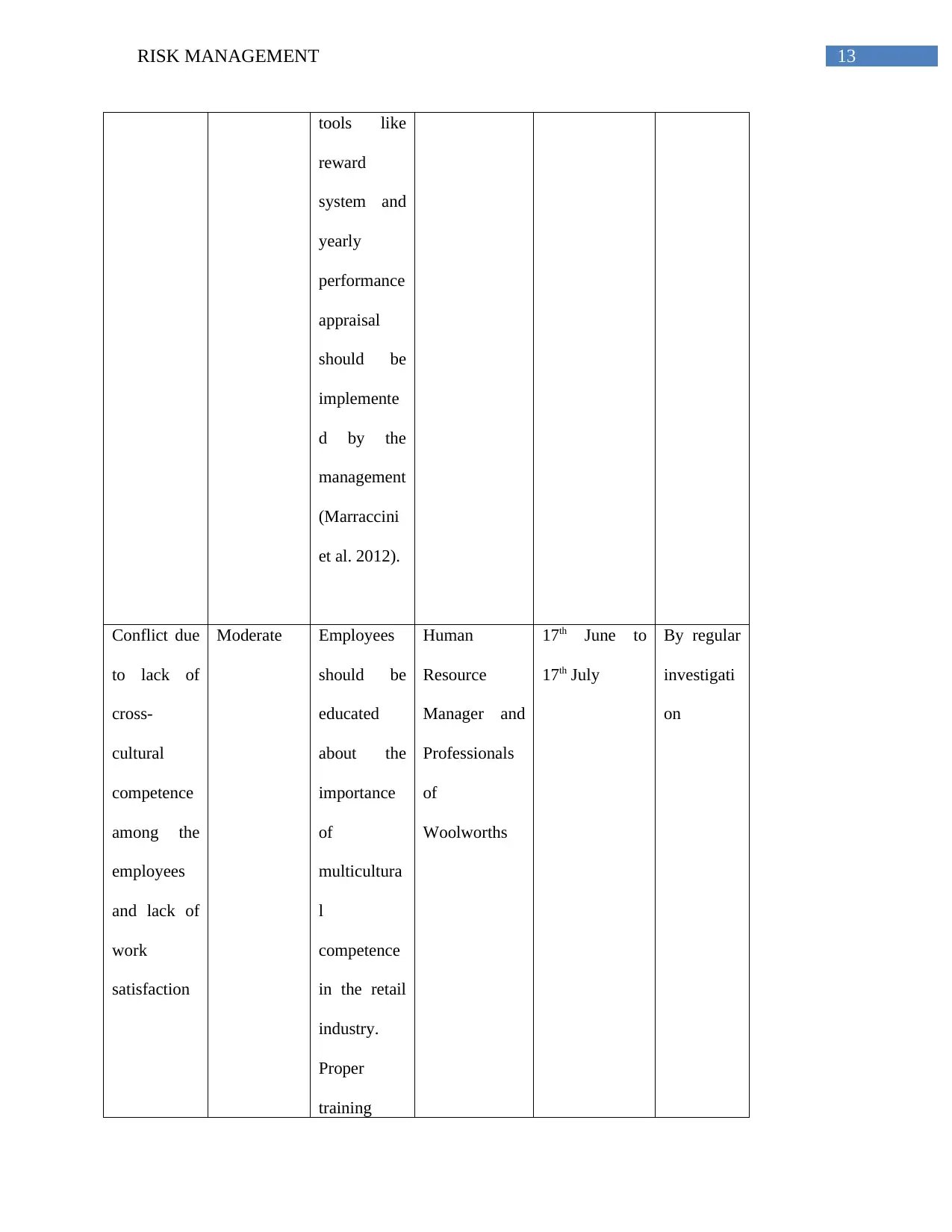
13RISK MANAGEMENT
tools like
reward
system and
yearly
performance
appraisal
should be
implemente
d by the
management
(Marraccini
et al. 2012).
Conflict due
to lack of
cross-
cultural
competence
among the
employees
and lack of
work
satisfaction
Moderate Employees
should be
educated
about the
importance
of
multicultura
l
competence
in the retail
industry.
Proper
training
Human
Resource
Manager and
Professionals
of
Woolworths
17th June to
17th July
By regular
investigati
on
tools like
reward
system and
yearly
performance
appraisal
should be
implemente
d by the
management
(Marraccini
et al. 2012).
Conflict due
to lack of
cross-
cultural
competence
among the
employees
and lack of
work
satisfaction
Moderate Employees
should be
educated
about the
importance
of
multicultura
l
competence
in the retail
industry.
Proper
training
Human
Resource
Manager and
Professionals
of
Woolworths
17th June to
17th July
By regular
investigati
on
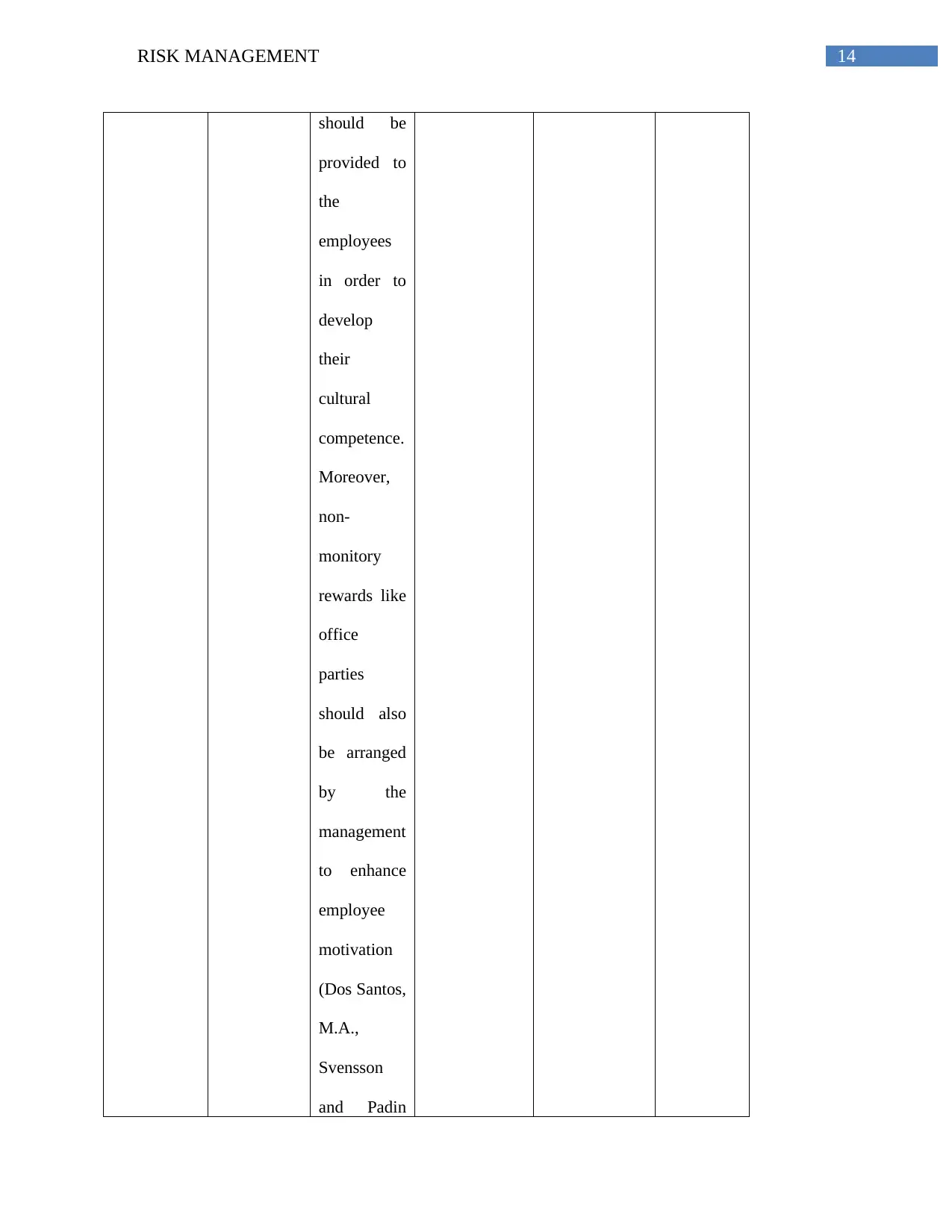
14RISK MANAGEMENT
should be
provided to
the
employees
in order to
develop
their
cultural
competence.
Moreover,
non-
monitory
rewards like
office
parties
should also
be arranged
by the
management
to enhance
employee
motivation
(Dos Santos,
M.A.,
Svensson
and Padin
should be
provided to
the
employees
in order to
develop
their
cultural
competence.
Moreover,
non-
monitory
rewards like
office
parties
should also
be arranged
by the
management
to enhance
employee
motivation
(Dos Santos,
M.A.,
Svensson
and Padin

15RISK MANAGEMENT
2013)
Loss of
consumer
loyalty due
to
inefficient
service and
decrement
in the
quality of
products
offered by
the
company to
the
consumers
High Training
should be
provided to
the
employees
in order to
enhance
their
professional
skills.
Human
Resource
Manager and
Professionals
of
Woolworths
17th June to
17th July
By regular
assessment
of the
skills of
the
employees
Table 4: Risk Treatment Plan
Source (Create by Author)
2013)
Loss of
consumer
loyalty due
to
inefficient
service and
decrement
in the
quality of
products
offered by
the
company to
the
consumers
High Training
should be
provided to
the
employees
in order to
enhance
their
professional
skills.
Human
Resource
Manager and
Professionals
of
Woolworths
17th June to
17th July
By regular
assessment
of the
skills of
the
employees
Table 4: Risk Treatment Plan
Source (Create by Author)
Secure Best Marks with AI Grader
Need help grading? Try our AI Grader for instant feedback on your assignments.
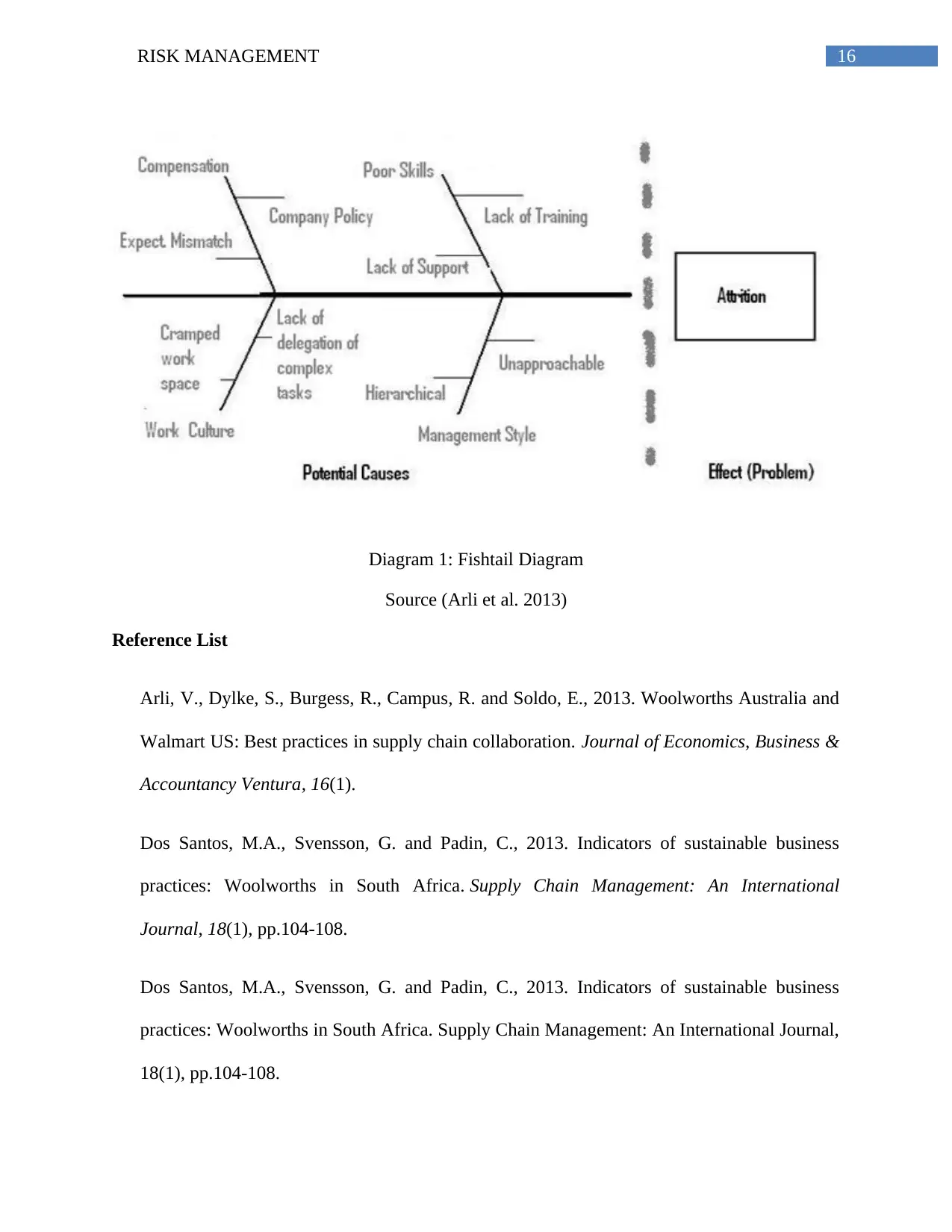
16RISK MANAGEMENT
Diagram 1: Fishtail Diagram
Source (Arli et al. 2013)
Reference List
Arli, V., Dylke, S., Burgess, R., Campus, R. and Soldo, E., 2013. Woolworths Australia and
Walmart US: Best practices in supply chain collaboration. Journal of Economics, Business &
Accountancy Ventura, 16(1).
Dos Santos, M.A., Svensson, G. and Padin, C., 2013. Indicators of sustainable business
practices: Woolworths in South Africa. Supply Chain Management: An International
Journal, 18(1), pp.104-108.
Dos Santos, M.A., Svensson, G. and Padin, C., 2013. Indicators of sustainable business
practices: Woolworths in South Africa. Supply Chain Management: An International Journal,
18(1), pp.104-108.
Diagram 1: Fishtail Diagram
Source (Arli et al. 2013)
Reference List
Arli, V., Dylke, S., Burgess, R., Campus, R. and Soldo, E., 2013. Woolworths Australia and
Walmart US: Best practices in supply chain collaboration. Journal of Economics, Business &
Accountancy Ventura, 16(1).
Dos Santos, M.A., Svensson, G. and Padin, C., 2013. Indicators of sustainable business
practices: Woolworths in South Africa. Supply Chain Management: An International
Journal, 18(1), pp.104-108.
Dos Santos, M.A., Svensson, G. and Padin, C., 2013. Indicators of sustainable business
practices: Woolworths in South Africa. Supply Chain Management: An International Journal,
18(1), pp.104-108.

17RISK MANAGEMENT
Haji Ali Afzali, H., Gray, J., Beilby, J., Holton, C., Banham, D. and Karnon, J., 2013. A risk‐
adjusted economic evaluation of alternative models of involvement of practice nurses in the
management of type 2 diabetes. Diabetic Medicine, 30(7), pp.855-863.
Keith, S., 2012. Coles, Woolworths and the local. Locale: The Australasian-Pacific Journal
of Regional Food Studies, 2, pp.47-81.
King, L. and Thobela, S., 2014. Woolworth's farming for the future. International Food and
Agribusiness Management Review, 17(B).
Knox, M., 2015. Supermarket monsters: The price of Coles and Woolworths'
dominance (Vol. 6). Black Inc..
Marraccini, T., Meltzer, S., Bourne, L. and Elizabeth Draper, C., 2012. A qualitative
evaluation of exposure to and perceptions of the Woolworths Healthy Tuck Shop Guide in
Cape Town, South Africa. Childhood Obesity (Formerly Obesity and Weight
Management), 8(4), pp.369-377.
Pang, L.P., Chen, S. and Wang, J.H., 2015. Risk management in portfolio applications of
non-convex stochastic programming. Applied Mathematics and Computation, 258, pp.565-
575.
Woods, M., 2012. Risk management in organizations: An integrated case study approach.
Routledge.
Haji Ali Afzali, H., Gray, J., Beilby, J., Holton, C., Banham, D. and Karnon, J., 2013. A risk‐
adjusted economic evaluation of alternative models of involvement of practice nurses in the
management of type 2 diabetes. Diabetic Medicine, 30(7), pp.855-863.
Keith, S., 2012. Coles, Woolworths and the local. Locale: The Australasian-Pacific Journal
of Regional Food Studies, 2, pp.47-81.
King, L. and Thobela, S., 2014. Woolworth's farming for the future. International Food and
Agribusiness Management Review, 17(B).
Knox, M., 2015. Supermarket monsters: The price of Coles and Woolworths'
dominance (Vol. 6). Black Inc..
Marraccini, T., Meltzer, S., Bourne, L. and Elizabeth Draper, C., 2012. A qualitative
evaluation of exposure to and perceptions of the Woolworths Healthy Tuck Shop Guide in
Cape Town, South Africa. Childhood Obesity (Formerly Obesity and Weight
Management), 8(4), pp.369-377.
Pang, L.P., Chen, S. and Wang, J.H., 2015. Risk management in portfolio applications of
non-convex stochastic programming. Applied Mathematics and Computation, 258, pp.565-
575.
Woods, M., 2012. Risk management in organizations: An integrated case study approach.
Routledge.
1 out of 18
Related Documents
Your All-in-One AI-Powered Toolkit for Academic Success.
+13062052269
info@desklib.com
Available 24*7 on WhatsApp / Email
![[object Object]](/_next/static/media/star-bottom.7253800d.svg)
Unlock your academic potential
© 2024 | Zucol Services PVT LTD | All rights reserved.





